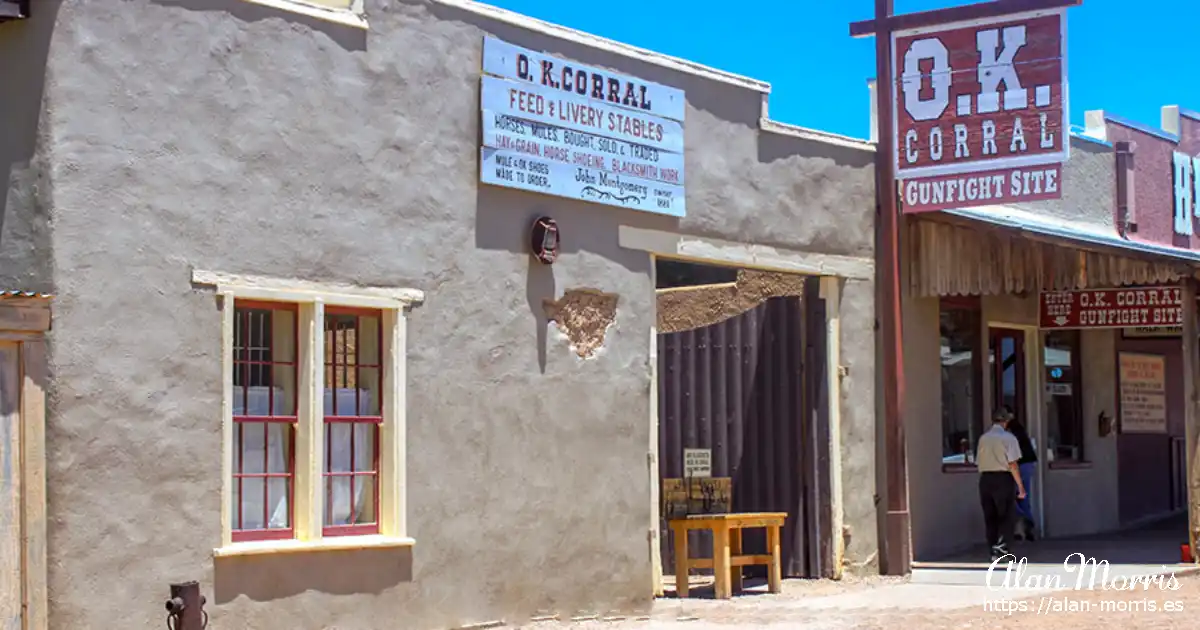While in Tombstone, Arizona, I visited Boothill Graveyard and the OK Corral.
Looking around Boothill's graveyard was very interesting, and some of the gravestones and monuments had very funny engravings on them. The OK Corral was surprisingly small, and the mechanical show was so bad it was funny. Unfortunately, we were not there long enough to see any of the shows that were put on in the streets.
My Uncle Dave and I stopped in at the 'Big Nose Kates' Saloon, where we were accosted at the door by a dirty, low-down Tottenham Hotspurs fan who objected to letting me in as I was wearing my Arsenal shirt. The man had lived initially in Tottenham in London and now lived in Tombstone and worked in the saloon. Before you ask, he was wearing spurs on his boots. We had a lovely meal and a beer here before shooting a game of pool on the old table in the saloon.
History.
Tombstone is a historic western city in Cochise County, Arizona. It was founded in 1879 by Ed Schieffelin in Pima County, Arizona Territory. It was one of the last wide-open frontier boomtowns in the American Old West. The town prospered from about 1877 to 1890, during which time the town's mines produced $40 to $85 million in silver bullion, Arizona's largest productive silver district. Its population grew from 100 to around 14,000 in less than seven years. It is best known as the site of the Gunfight at the OK Corral and draws most of its revenue from tourism.
The town was established on a mesa above the Tough Nut Mine. Within two years of its founding, although far distant from any other metropolitan city, Tombstone boasted a bowling alley, four churches, an ice house, a school, two banks, three newspapers, and an ice cream parlour, alongside 110 saloons, 14 gambling halls and numerous dancing halls and brothels. All these were situated among and on top of many dirty, hardscrabble mines. The gentlemen and ladies of Tombstone attended operas presented by visiting acting troupes at the Schieffelin Hall opera house. At the same time, the miners and cowboys saw shows at the Bird Cage Theatre, "the wildest, wickedest night spot between Basin Street and the Barbary Coast".
Under the surface were tensions that grew into deadly conflict. The mining capitalists and townspeople were primarily Republicans from the Northern states. Many of the ranchers in the area were Confederate sympathisers and Democrats. The booming city was only 30 miles from the Mexico border and was an open market for beef stolen from ranches in Sonora, Mexico, by a loosely organised band of outlaws known as The Cowboys. The Earp brothers, Virgil, Wyatt, Morgan and Warren, arrived in December 1879 and summer 1880. They had ongoing conflicts with Ike and Billy Clanton, Frank and Tom McLaury, and other Cowboys members. The Cowboys repeatedly threatened the Earps for months until the conflict escalated into a confrontation that became a shootout, the now famous Gunfight at the OK Corral. The actual gunfight was on Fremont Street, a block or two away from the OK Corral.
In the mid-1880s, the silver mines penetrated the water table, and the mining companies invested significantly in specialised pumps. A fire in 1886 destroyed the Grand Central hoist and pumping plant, and it was unprofitable to rebuild the costly pumps. The city nearly became a ghost town, only saved from that end because it was the Cochise County seat until 1929. The city's population dwindled to a low of 646 in 1910, but in 2010 the population was 1,380.
OK Corral.
The OK Corral was originally (from 1879 to about 1888) a livery and horse corral in the mining boomtown of Tombstone, Arizona. Despite its famous association with the Gunfight at the OK Corral, the shoot-out took place in a narrow lot six doors west of the rear entrance to the corral, between Harwood's home and C. S. Fly's 12-room boarding house and photography studio.
The 1957 film Gunfight at the OK Corral made the shootout famous, and the corral became the location of the altercation in the public's mind. The corral is currently marketed as the location of the shootout, and visitors can pay to see a reenactment of the gunfight. The corral is now part of the Tombstone Historic District.
Boothill Graveyard.
Originally called Boothill Cemetery, the graveyard was founded in 1878. After a new city cemetery was built elsewhere, the old cemetery stopped accepting new burials in about 1883 (save for very few exceptions). It fell into disrepair until the 1940s, when the city began to restore and preserve it.
